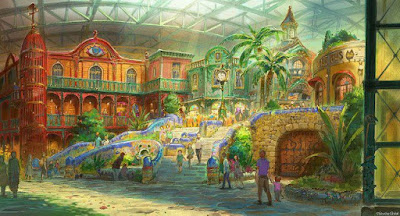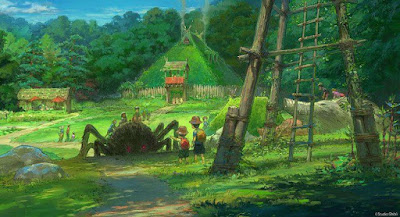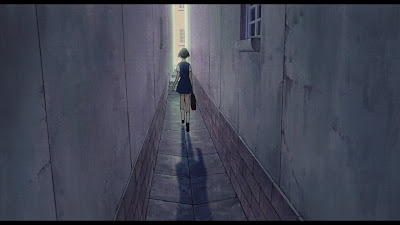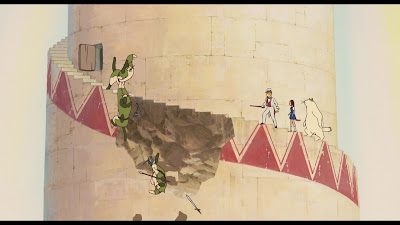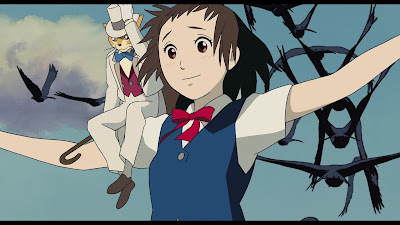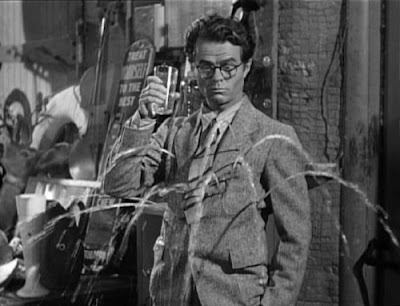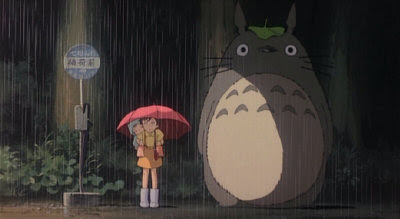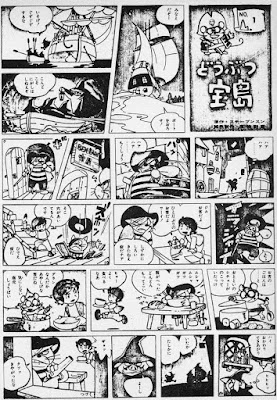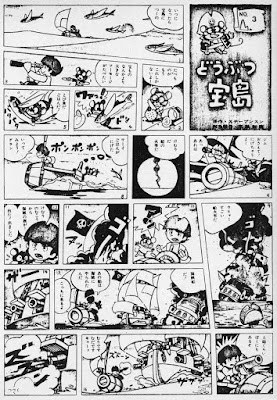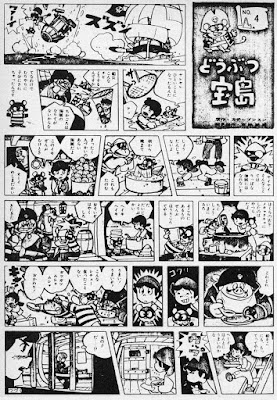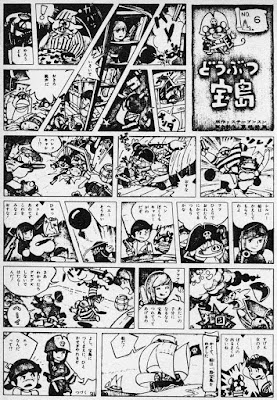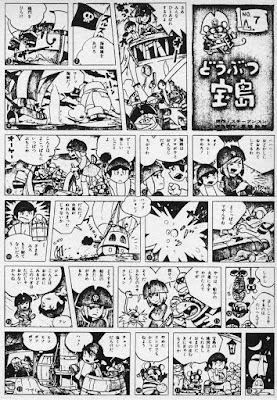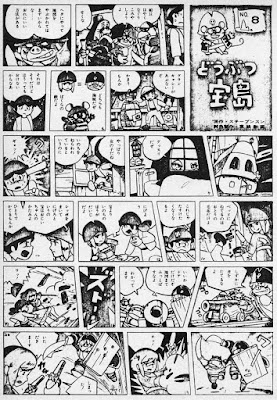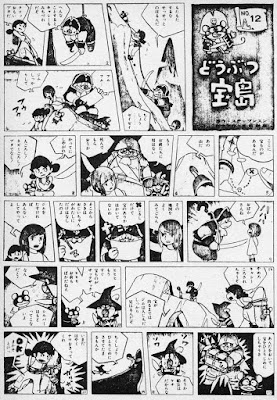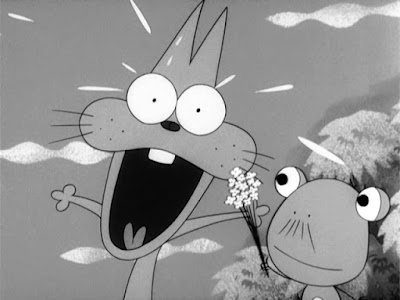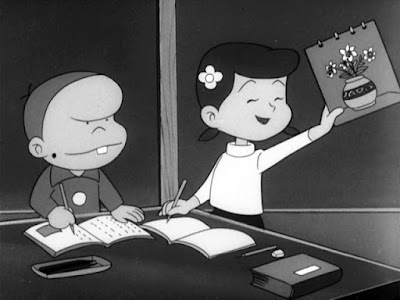The ultimate test for any diehard Studio Ghibli fan is spotting all the "Ghibli Riffs," the shots and moments that directly quote earlier works. It is a staple of the Takahata-Miyazaki canon and is found in all of their films and television series. Today, we're taking a look at Takahata's 1999 masterwork My Neighbors the Yamadas.
Watching our new Blu-Ray copy this weekend, I was struck by how few riffs appear in this movie. Most Ghibli movies contain well over a dozen riffs without breaking a sweat, while Yamada-kun only contains half that amount. Instead, there are a number of nods to classic cinema, which is a Takahata trademark that goes back years (Heidi and Anne of Green Gables both quote Citizen Kane, Horus cites Alexander Nevski).
Let's take a look at all the riffs in Yamadas:
1. The opening scene portrays a number of images that directly quote Japan's hanafuda cards as the main characters are introduced. This very same thing appeared in Takahata's great film Jarinko Chie (1981).
Also, is my memory playing tricks with me, or was the shot of the bird on the branches, another Hanafuda card illustration and seen in Jarinko Chie, also riffed in Pom Poko (1994)? Somebody should check that to be sure.
2. Two shots show a fascinating still-shot montage that reminds me very much of the introductory shots of the farming family in Omohide Poro Poro (1991). Both share the same fascinating blend of flat 2D images in a moving 3D landscape. I'm also reminded of View-Master, but that's probably just me.
3. Every Paku-san fan will immediately spot this shot. It's quoting the opening to Heidi, Girl of the Alps (1974). Speaking of which, is everyone getting enjoying their Heidi marathons? Don't forget that the Japanese (w/subtitles) and Espanol versions are available here on Ghibli Blog.
4. This shot is a really clever bit of comic timing and editing, showing a pack of hungry sharks that pop up to watch Jaws playing on the teevee set. It's a nice little nod to an iconic movie that may also touch upon the movie's running commentary on daily reality versus fantasy escapism that Takahata critiques.
5. This short scene of the family signing a popular Japanese song was previously heard in Omohide Poro Poro, in the scene where the school children are having their "class parliament" session. Also, I kinda want one of those table-and-pillow sets for the living room.
6. This bit where Matsuko tricks her son into cooking ramen noodles includes a short cut of the mother walking down the screen, top to bottom, only feet shown. This shot originally appeared an episode of Heidi. Hayao Miyazaki also riffed that same shot in Princess Mononoke, in the shots of the Shishigami walking in darkness, his footsteps spawning plant life at an accelerated lifespan.
7. This scene where Takashi daydreams is another Takahata trademark, as the outside world dissolves and we enter into the inner worlds of the characters' minds. Anne of Green Gables (1979) and Gauche the Cellist (1982) are probably my favorite examples.
8. This funny scene of Takashi trying to take a family photo while everyone else is glued to the television is another great moment where Paku-san criticizes escapism at the expense of missing out on daily life. But did you also spot the movie that was playing? It looks exactly like a scene from Horus, Prince of the Sun. Nice. Oh, and Hayao Miyazaki also quoted that same shot in Ali Baba and the 40 Thieves (1971).
9. This great little comic moment of Noboru wrecking his room in a fit of joy is a wonderful nod to Charlie Chaplin's classic movie The Gold Rush. Be sure to grab that movie on Criterion Blu-Ray, which features the original 1925 release that is waaay better than the 1940s remix.
10. Yamada's most dramatic sequence is this extended story where Takashi is compelled to stand up against a pack of neighborhood bullies but is humiliated instead. Sitting alone on a park swing, he imagines himself as the caped superhero Kamen Rider, who bravely chases villains, fires a pistol and performs wild motorcycle stunts. The illusion of fantasy versus the harsh reality of real life is portrayed in stark, tragic terms. The shot of the father on the swing has always reminded me of Akira Kurosawa's masterful Ikiru.
11. This poignant scene of Takashi on his way to work includes this compelling shot of him riding in a crowded train, lost in a sea of anonymous faces. Pom Poko also featured a nearly identical shot of one of the main tanuki characters, who is forced to survive by assimilating into the human world and its soul-crushing salaryman lifestyle.
12. This shot of a crowd moving at a diagonal angle reminds me of a nearly identical shot from Horus, Prince of the Sun. Hayao Miyazaki also riffed the same shot in Nausicaa of the Valley of Wind (1984) and Kiki's Delivery Service (1989).
13. The magnificent song-and-dance finish with the Yamadas floating through the air on umbrellas is actually a direct quote from The Story of Perrine, the 1977 season of World Masterpiece Theater, specifically the opening sequence where cartoon characters float on dandelions through the air. Takahata also riffed the same shot in Gauche the Cellist. This has always fascinated me; Paku-san assisted the Perrine team on storyboards for one or more episodes, but only in a supporting fashion.
Coda. In addition to the Ghibli and cinema riffs, My Neighbors the Yamadas has a number of visual references to Japanese art and folklore, including the famous Hokusai painting, The Great Wave of Kanagawa, and various stories about where children come from. The Tale of the Bamboo Cutter is most fascinating, as it leads directly to The Tale of the Princess Kaguya (2013), Takahata's final masterpiece.
There are also many musical cues to Japanese and Western classical and modern popular songs that always leaves me inspired and overwhelmed. One of the great joys of a Takahata movie is enjoying the wonderful music and being swept along in his world. When Studio Ghibli was founded, Toshio Suzuki proclaimed, "we want to create movies that celebrate the joys and sorrows of life." I can't think of a more perfect illustration of that mantra than My Neighbors the Yamadas. This movie is a miraculous celebration of art and life.




